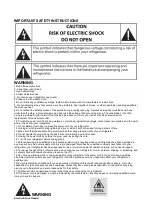
Take extra care with meat and fish
Cooked meats should always be stored on a shelf above raw meats to avoid bacterial transfer. Keep raw meats on a plate
which is large enough to collect juices and cover it with cling film or foil.
Leave space around food
This allows cold air to circulate around the Fridge, ensuring all parts of the Fridge are kept cool.
Wrap up food!
To prevent transfer of flavors and drying out, food should be separately packed or covered. Fruit and vegetables need not
be wrapped.
Pre-cooked food should be cooled properly
Allow pre-cooked food to cool down before placing in the Fridge. This will help to stop the internal temperature of the
Fridge from rising.
Shut the door!
To prevent cold air escaping, try to limit the number of times you open the door. When
returning
from shopping, sort foods
to be kept in your Fridge before opening the door. Only open the door to put food in or take it out.
Where to store your foods in the fridge
Cool area
This is where to store foods which will keep longer if they are kept cool. Milk, eggs, yogurt, fruit juices, hard cheeses eg.
Cheddar. Opened jars and bottles of salad dressings, sauces and jams. Fats, eg. Butter, margarine, low-fat
spreads
,
cooking fats and lard.
Coldest area
This is where foods which must be cold to keep them safe should be kept:
·Raw and uncooked foods should always be wrapped.
·Pre-cooked chilled foods, eg. Ready meals, meat pies, soft cheeses.
·Pre-cooked meats eg. Ham,
·Prepared salads(including pre-packed mixed green salads, rice, potato salad etc).
·Desserts, eg. Fromage frais, home-prepared food and leftovers or cream cakes.
NOTE
:
Always wrap and store raw meat, poultry and fish on the lowest shelf at the
bottom of the fridge. If so, can not put too long. This will stop them dripping onto, or
touching other foods. Do not store inflammable gasses or liquids in the fridge.
Recommended storage periods
For recommended food storage time, refer to the information given on your food packaging.
Cleaning inside the Fridge
After defrosting you should clean the Fridge internally with a weak solution of bicarbonate of soda. Then rinse with warm
water using a damp sponge or cloth and wipe dry. Wash the baskets in warm soapy water and ensure they are completely
dry before replacing in the Fridge.
Cleaning outside the Fridge
Use standard non-abrasive detergent diluted in warm water to clean the Fridge exterior.
The grille of the condenser at the back of the Fridge and the adjacent components can be vacuumed using a soft brush
attachment.
Do not use harsh cleaners, scouring pads or solvents to clean any part of the Fridge
TROUBLE SHOOTING AND MAINTENANCE
Trouble Shooting
Power cut
Do not open the Fridge door more than necessary.
The Fridge is exceptionally cold
You may have accidentally adjusted the thermostat control dial to a higher position.
The Fridge is exceptionally warm
The compressor may not be working. Turn the thermostat control dial to the maximum setting and wait a few minutes. If
there is no humming noise, it is not working. Contact the local store where your purchase was made.
The Fridge is not working
Check it is plugged in and switched on. Check that the fuse in the plug has not blown. Leave the Fridge for 30 minutes.
Condensation appears on the outside of the Fridge
This may be due to a change in the room temperature. Wipe off any residue of moisture. If the problem continues contact
the local store where your purchase was made.
GURGLING, WHOOSHING
These noises are caused by the circulation of the refrigerant liquid in the cooling system. It has become more pronounced
since the introduction of CFC free gases. This is not a fault and will not affect the performance of your Fridge.
HUMMING, PURRING OR PULSATING
This is the compressor motor working, as it pumps the refrigerant around the system.
Moving the Fridge/Freezer
Location
Do not place your Fridge/Freezer near a heat source, eg. Cooker, boiler or radiator. Also avoid direct sunlight in
out-buildings or sun lounges.
Leveling the Fridge/Freezer
Make sure the Fridge/Freezer is level. Use the rotating leveling feet at the front. If the Fridge/Freezer is not level, the
doors and magnetic seal alignments will be affected and may cause your Fridge/Freezer to work incorrectly.
Do not turn on the Fridge/Freezer for 4 hours
After the Fridge/Freezer is in place it needs to be left for 4 hours. This allows time for the coolant to settle.
Installation





